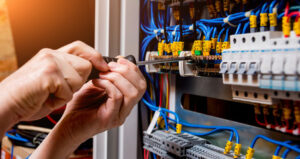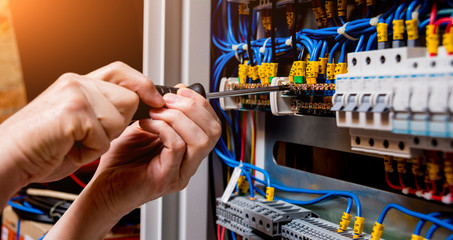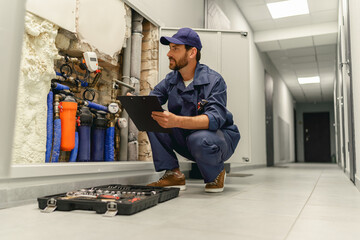Licensed electricians are trained and experienced professionals that offer quality and reliability. Whether you’re building your dream home or repairing your office, they are there to provide the necessary services for safe and effective operations.
Regulatory compliance goes far beyond simple rule-following; it ensures longevity and safety for any project. This is what distinguishes their expertise and why it’s so valuable. Visit https://www.ampi-electricinc.com/fort-lauderdale-electrician/ to learn more.
Every home, office building, store, and factory needs an electrical system to power the lights and appliances that we use on a daily basis. Electricians install, repair, and maintain these systems to ensure that they continue to function properly and safely.
One of the primary duties of an electrician is to ensure that any electrical work they do is up to code and safe. This means that before starting any new installation, they must obtain the proper permits and notify the appropriate authorities of their activities. After completing all required steps, they must inspect their work to make sure that it meets all local safety and building regulations.
During the installation process, an electrician must carefully follow any blueprints or building plans to correctly wire a structure’s entire electrical system. This includes ensuring that all wires are connected to the correct outlets, switches, and other electrical fixtures. If any problems are identified, they must correct them immediately to prevent potential fire hazards or other dangerous situations.
Another major duty of electricians is to assess a home or business’s electrical needs and recommend any necessary upgrades. For example, older homes may not have sufficient outlets to accommodate modern electronics and appliances. In this case, an electrician would recommend installing additional outlets in strategic locations to meet these demands. In addition, if a building is being renovated or expanded, an electrician would be responsible for coordinating with contractors and architects to ensure that the electrical system is updated appropriately.
To install new electrical outlets, an electrician must first turn off the power to the area where the outlet will be located. This is done by shutting off the electricity at the circuit breaker or fuse box and then verifying that the power is truly off using a voltage tester. Next, they must determine the appropriate size of electrical box for the new outlet and then install it securely in the wall or surface. They must then run electrical cables from the panel to the outlet, connecting them using proper wiring techniques.
Electricians also install and repair a variety of other electrical fixtures, including switches, lighting, and generators. They can even replace old appliances with energy-efficient models to help reduce electricity bills and promote environmental sustainability.
Repair
Electricians repair faulty wiring or electrical devices like switches, outlets, and light fixtures. They use specialized tools to identify problems and replace components as needed. They may also perform routine maintenance to ensure that electrical systems operate correctly and safely. This includes examining circuit breakers and transformers for damage or signs of wear.
Some electricians specialize in residential or commercial electrical work. Others focus on a specific industry, like hospitals or the military. In most cases, these electricians must complete years of on-the-job training as an apprentice before becoming licensed professionals. Regardless of their specialty, all electricians must be able to read blueprints and understand the principles of electricity in order to install, repair, or maintain electrical systems.
Licensed electricians are accountable for their work and will never leave a project unfinished or skip important steps. They carry adequate insurance and surety bonds to cover their work, and they know how to follow all permit requirements for their area. This helps protect consumers from shady contractors who try to overcharge or take shortcuts that could lead to costly errors, like electrical fires and other hazards.
A professional electrician can assess your energy needs and recommend upgrades to improve efficiency. This can lower your costs and even save you money on your monthly utility bills. For example, a licensed electrician can suggest ways to update outdated wiring or install new lighting fixtures that are more energy-efficient.
In some situations, you might need to upgrade your electrical system to accommodate a new appliance or renovation. An experienced electrician can help you plan out your electrical system, determine the best materials for your project, and provide cost estimates before beginning the job.
Homeowners and business owners often attempt DIY electrical projects, but these tasks aren’t as simple as they seem. Working with electricity requires a lot of knowledge and skill, and any mistakes can put you or anyone else in harm’s way. Licensed electricians have the training and tools to perform these services safely and efficiently. They also have a deep understanding of how these systems work, so they can help you make the most of your energy budget.
Maintenance
Electrical maintenance services are performed on a regular basis to ensure that all equipment and wiring is working properly. This type of preventative maintenance can help businesses and homeowners avoid expensive repairs in the future. It can also help ensure that employees and customers are safe from electrical fires and shocks.
Electricians perform maintenance tasks in a variety of settings. Some specialize in residential or commercial work while others focus on specific types of equipment or installations. For example, a lineman may be responsible for the maintenance and repair of power lines, while an industrial electrician might focus on the wiring of manufacturing equipment.
In general, electrical maintenance involves checking for damage and repairing or replacing components that are worn out or not functioning correctly. This can include checking for exposed wires, which can pose a fire hazard if not repaired promptly. It can also involve testing and calibrating electrical components to ensure that they are working as intended. This includes checking the voltage of outlets, switches and other equipment.
It is also important to keep in mind that electrical maintenance can be a physically demanding job. This is because it often requires workers to lift and maneuver heavy objects. It can also require them to climb, squat and stand for long periods of time. This is why it is important to wear the appropriate safety equipment when performing electrical maintenance, such as rubber gloves, a hard hat and protective eyewear.
A qualified and licensed electrician should be familiar with all relevant local and state codes and regulations regarding the installation and maintenance of electrical systems. They should also be comfortable reading blueprints and technical diagrams to determine the location of circuits and other components. In addition, they should be able to follow instructions from engineers and other supervisors to complete installation and maintenance tasks. Finally, an electrician should be able to effectively communicate with their clients to determine the appropriate solutions for their electrical needs. This can be done through face-to-face meetings, phone calls or email correspondence. This is especially important when dealing with complex or dangerous projects.
Testing
Electrical testing is a crucial service that detects problems before they cause damage or pose a risk to people using the equipment. Professional electricians use a variety of tools, including voltage testers, continuity testers, and multimeters, to conduct these tests. They may also use more advanced equipment like oscilloscopes and infrared cameras for a more thorough inspection.
One common problem with electric systems is overload. Overloading causes the wiring and other components to heat up, which increases the risk of fires and electrical shock. This is why it’s so important to have your system inspected regularly. During a safety inspection, an electrician will check for signs of overheating in switches and sockets and replace any damaged or worn out components.
Another common issue is poor connections. Over time, electrical wires can become loose or damaged, which can cause a short circuit and lead to a fire hazard. To avoid this, your electrician will test all connections for continuity and resistance to make sure they’re secure. They will also look for any polarity issues that could cause the current to flow in the wrong direction, which can be dangerous.
Testing also includes a visual assessment of appliances and cables to check for any obvious defects. This is particularly important when preparing to sell a property, as it ensures the new owner will be safe to use the electrical system. Electricians can also provide an EICR test, or Electrical Installation Condition Report, which is a legal requirement for landlords and businesses.
Commercial buildings often require more extensive testing than residential properties. These tests help protect employees from potential hazards and reduce energy bills by identifying any issues before they become serious problems. A thorough commercial inspection can include a wired and wireless circuit test, a PAT (Portable Appliance Test) test, an earthing continuity test, a protective conductor continuity test, and an RCD/Safety Switch test. An electrician can also recommend upgrades to paneling or other components if necessary. These improvements will help the building meet current electrical standards and ensure it’s up to code. If you’re ready to schedule an inspection, contact SESCOS today.





